- Submissions

Full Text
Advancements in Civil Engineering & Technology
A Framework for the Assessment of Public Buildings Sustainability in the Palestinian Territory
Aya Baba1*, Isam Shahrour1 and Mutasim Baba2
1Civil and geo-Environmental Engineering Laboratory (LGCgE), France
2An-Najah National University, Palestine
*Corresponding author: Aya Baba, Civil and geo-Environmental Engineering Laboratory (LGCgE), Lille University, 42 Rue Paul Duez, 5900 Lille, France
Submission: August 11, 2021;Published: August 25, 2021

ISSN: 2639-0574 Volume4 Issue5
Abstract
Public authorities in developing countries have a significant role in the application of sustainability in the building sector. They are responsible for: (i) adopting new regulations and guidelines about sustainability requirements in the design, construction, and management of buildings and (ii) the use of sustainability as an essential requirement for the construction and renovation of public buildings. However, since the application of sustainability in the construction sector approach is still embryonic in developing countries, a significant effort is required to adopt international knowledge and experience in sustainability. This paper aims to fill this gap by developing a framework for assessing the sustainability of public buildings in the Palestinian territory. The framework includes establishing sustainability indicators for public buildings based on the literature review and the opinion of a panel of experts. The paper presents the methodology followed to identify these indicators and uses the Step-Wise Weight Assessment Ratio Analysis method (SWARA) for their ranking and weighting. As a major result, the paper provides a set of indicators for assessing the sustainability of public buildings and the ranks and weights of these indicators. The set of indicators is organized in the following categories: energy efficiency, water efficiency, green city, and Indoor environment.
Keywords: Public buildings; Sustainability; Developing countries; Social; Economic; Green; Energy; Water; Indicator; Framework
Introduction
This paper presents a framework for the assessment of the sustainability of public
buildings in Palestine. The significance of this research is threefold. The first fold is related
to the significant environmental, social and economic role of the building sector 7 [1]. Indeed
this sector is responsible for approximately 40% of the energy consumption, 36% of CO2
emissions, 33% water consumption, and 30% of waste generation 18,4 [2,3]. In addition, the
building construction industry consumes a significant amount of resources: 25% of wood
and steel products and 70% of cement [4]. The second fold concerns the application of
sustainability in public buildings, which provide services to the community such as education,
health, sport, culture, and administration [5]. They also host the administrative and technical
staff of the public sector. Public buildings also significantly impact the environment, primarily
through energy and water consumption. Moreover, this sector requires high investments to
meet the sustainability challenges [6]. Gelderman et al. [7] reported that the research about
sustainability studies focused on the private sector resulting in a lack of studies in the public
sector. The assessment of four public buildings in Catalonia [8] showed that the public service
was an ideal target for implementing decision-making methodologies to ensure a balance in
social inclusion, environmental preservation, and economic development viability.
The third fold concerns Palestinian territory as an example of developing countries.
Indeed, sustainability was mainly designed and applied in developed countries [9]. Standards
and certificates were set in these countries for designers, practitioners, and decision-makers.
Examples of these certificates are LEED in the USA, BREEAM in the UK, CASBEE in Japan, DGNB in Europe, GB Tool in Canada, Life-cycle-based tools in
the Netherlands, and Eco-Effect in Sweden [2,9,10]. Since these
certificates were developed within developed countries, they
could not be directly applicable to developing countries because of
specific policies, regulations, public awareness, geography, climate,
resource, and construction materials [4]. Ali [11] emphasized that
building assessment has become a necessity in developing countries
to encourage and support the construction industry to enter the
path of sustainability. Vyas [12] developed a framework to measure
the sustainability of a building based on factors applicable to
Indian status. Banani et al. [13] proposed a sustainable framework
assessment for non-residential construction in Saudi Arabia.
Public authorities in developing countries have a significant
role in the application of sustainability in the building sector. They
are responsible for: (i) adopting new regulations and guidelines
about sustainability requirements in the design, construction,
and management of buildings and (ii) the use of sustainability as
an essential requirement for the construction and renovation of
public buildings. However, since the application of sustainability in
the construction sector approach is still embryonic in developing
countries, a significant effort is required to adopt international
knowledge and experience in sustainability. This paper aims to fill
this gap by developing a framework for assessing the sustainability
of public buildings in the Palestinian territory. The framework
includes establishing sustainability indicators for public buildings
based on the literature review and the opinion of a panel of experts.
The paper presents the methodology followed to identify these
indicators and the use of the Step-Wise Weight Assessment Ratio
Analysis method (SWARA) [14] for their ranking and weighting.
Research Methodology
Research design
Figure 1 details the methodology followed in this research. It includes 3 phases. The first phase identifies a set of sustainability indicators for the public buildings in Palestine using both literature review and analysis of practices and needs in this sector. The second phase concerns the consultation of a panel of experts about the first set of indicators and their importance. Finally, the third phase includes analyzing the experts’ opinions using the SWARA method to figure out the final set of sustainability indicators for the public buildings in Palestine and determine a weighting system for these indicators.
Figure 1: Methodology followed for the determination of sustainability indicators for public buildings in Palestine.

Sustainability indicators for public buildings in Palestine
Since the concern for sustainability in the building sector in Palestine is recent, there is a great need to investigate international practices in this area and their adaptation to the local context [15]. This adaptation should consider the specific situation in Palestine, mainly the occupation, which reduces the power of control of the national authority over its lands, borders, and resources [16]. The construction industry is one of the main sectors that affect the Palestinian economy. In 2010, this sector recorded a growth rate of about 36%. In addition, this sector is the second-largest contributor to the Goss Domestic Product (GDP). It accounted for about 13% of the GDP in 2014 [15].
Establishing guidelines for sustainable buildings in Palestine requires determining indicators for the three pillars of sustainability: environment, social and economic. It should be based on the international experience and the specificities of the public buildings in the Palestinian context. Analysis of the international sustainability assessment methods (LEED and BREEAM), other international experiences, and the Palestinian Green Building Guidelines allowed constructing the first set of indicators. The proposed methodology follows the proposition of Balaras et al. [3] for a three-level sustainability assessment hierarchy: Issues, Categories, and Indicators (Criteria). The level “Issue” defines the general themes to assess sustainability: environment, society, and economy. Each issue has different “Categories”. Each category illustrates the specific aspect related to some indicators. Finally, the “indicator” describes the category’s aspect and represents the main valuation entries used to describe a building. These indicators can be qualitative or quantitative.
The following sections present successively the environmental, social, and economic indicators
Environmental indicators
Table 1 summarizes the environmental category. It includes four subcategories: (I) Energy efficiency (II) Water efficiency (III) Green city and (IV) Indoor environment quality.
Table 1: First set of indicators for sustainable public buildings in Palestine (Environmental category).
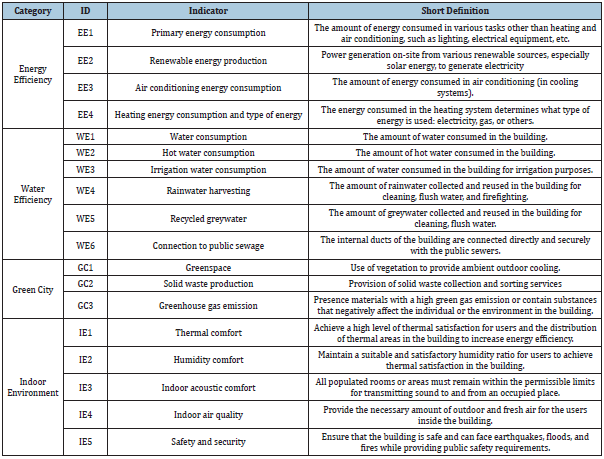
A. Energy efficiency
The energy efficiency of buildings has become a critical concern in the building’s life cycle management. As mentioned before, the building sector constitutes a significant consumer of energy in the world. Energy consumption is also associated with excessive use of resources. Moreover, the energy production process is responsible for harmful and toxic emissions into the atmosphere [4]. Therefore, most assessment tools focus on energy management [17]. Energy has the highest weighting among the other categories with 25% and 21% scores in the LEED and BREEAM sustainable rating systems, respectively. The energy category for Palestine is particularly critical because Palestine suffers from deprivation from exploiting its natural resources, such as the production or import of electricity and natural gas. The Palestinian National Authority (PNA) has to import 100% of petroleum products from the Israeli market and around 87% of electrical energy from the Israeli Electric Corporation (Said, 2019). The energy efficiency category includes four indicators: (EE1) Primary energy consumption, (EE2) Renewable energy production, (EE3) Air conditioning energy consumption, and (EE4) Heating energy consumption and type of energy, as seen in Table 1.
B. Water efficiency
Water scarcity constitutes a significant challenge in Palestine because of the considerable damages to the water resources and infrastructures [16]. Consequently, the public authority is concerned with the improvement of the water efficiency system. In addition, it is necessary to consider new water sources such as rain harvesting and greywater treatment. The policy for water efficiency category is based on six indicators: (WE1) Water Consumption, (WE2) Hot water consumption, (WE3) Irrigation water consumption, (WE4) Quantity of rainwater harvesting, (WE5) Recycled greywater, and (WE6) Connection to public sewage as seen in Table 1.
C. Green city
Green areas constitute an essential factor for the quality of life. Considering the high density of buildings in urban areas, they have a crucial role in achieving the objective of a green city. Three indicators are considered for the contribution of public buildings to the green city: (i) Percentage of green areas (GA1), (ii) Solid waste production (GA2), which aims to reduce construction waste by sorting solid construction waste for secondary use and recycling, and (iii) the reduction of Greenhouse gas emissions is considered as one of the priorities towards sustainable development of any country.
D. Indoor environment quality
This category aims to improve the quality of the internal environment, maintain users’ health and comfort, and improve productivity. Most people spend approximately 90% of their time in buildings [4]. There is a tangible link between individuals’ health, comfort, productivity, and environmental conditions [18]. According to the Palestine Higher Green Building Council (2013), the improvement of the indoor environment could (i) reduce the number of workdays lost due to illness by an average of 3 days per person per year and (ii) increase individual productivity by about 5%. This category is the second after the energy category by weight, with 22% and 15% in the LEED and BREEAM sustainable rating systems, respectively.
This category includes five indicators: (IE1) Thermal comfort, (IE2) Humidity comfort, (IEQ3) Indoor acoustic comfort, (IE4) Indoor Air quality, and (IE5) Safety and security, as seen in Table 1.
Social indicators
This category focuses on the social services of public buildings. It is essential to understand population needs and seek longterm collective well-being [8]. It helps improve inclusion, equity, employment, security, education, satisfaction, participation, and accessibility to public services. In addition, it must ensure that the community values are involved in the decision-making process. Tammy et al. [19] showed that the rating system tool failed to understand the social dimension of buildings. Table 2 summarizes the list of the indicators of the social category. It includes five indicators. The Public transport service indicator (SA1) which concerns the availability of building to the members of society, especially disabled people. It encourages the building’s location to be near to public transportation services. The second indicator concerns the use of public facilities for social activity (SA2). The 3rd indicator measures the daily occupation rate of the building (SA3), while the fourth indicator focuses on the hourly occupation rate of buildings (AS4). The last indicator is related to cultural heritage (AS5).
Table 2: First set of indicators for sustainable public buildings in Palestine (Social category).

Economic indicators
The economic factor is crucial in developing countries, which must be considered in buildings sustainability assessment. However, the economic dimension is not central in BREEM, LEED, GB Tool and CASBEE. While economic incentives and financing schemes are commonplace programs for green building design in the United Kingdom, the United States, and Japan, they are not yet implemented in developing countries [17,19]. The economic category concerns the total building operations and maintenance costs. It includes two indicators (Table 3): (i) The Operational energy expenses (EC1), which covers services related to heating, air conditioning, lighting, and others, and (ii) the Operational water expenses (EC2), which covers services such as potable water, flush water, cleaning, and irrigation.
Table 3: First set of indicators for sustainable public buildings in Palestine (Economic category).

Experts’ opinion
The set of indicators established in the previous section was submitted through a questionnaire to a panel of experts for evaluation and extension. This approach was used by Olawumi [20] to identify and prioritize sustainability practices in construction projects. In addition, they reported that it helped reach consensus in complex projects. Experts were selected according to their experience and expertise in the construction and building sector and sustainable and green buildings. The questionnaire is composed of two sections. The first section concerns the experts’ profile, including education level, expertise, and working sector. The second section includes the evaluation by the experts of the importance of sustainability indicators according to a 5-level score (Table 4). Low scores indicate low significance, while high scores indicate high relevance. Experts were also invited to propose additional indicators for the sustainability of public buildings. Twenty-nine (29) responses were received from experts. Table 5 summarizes the profile of these experts. Around 60% of them are Ph.D. graduates. They cover extensive construction activities such as architecture, civil and buildings engineering, mechanical engineering, management and urban planning, and environmental engineering. Around 55% of the experts are architects. Around half of the experts works in the public sector, and the other half works in the private sector.
Table 4: Scores used in the experts’ evaluation of the importance of sustainability indicators.

Table 5: Profiles of experts.
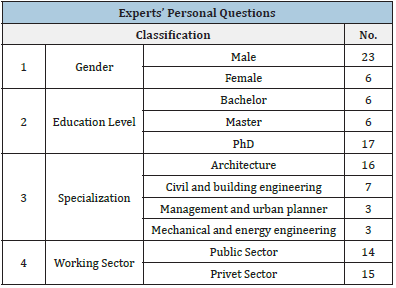
Data analysis
Data analysis aimed at ranking the indicators according to the experts’ opinion and determining their relative weight to determine the global score of sustainability. This work was conducted using the Stepwise Weight Assessment Ratio Analysis (SWARA) method [14]. This method was used by Zolfani & Chatterjee [21] to analyze the experts’ opinions. In this method, experts use their knowledge and experiences to determine the importance of each indicator [22]. The indicators ranking and weighting are then determined according to the following five steps [14] (Figure 2):
Figure 2: Determining the criteria weights based on the SWARA method [14].
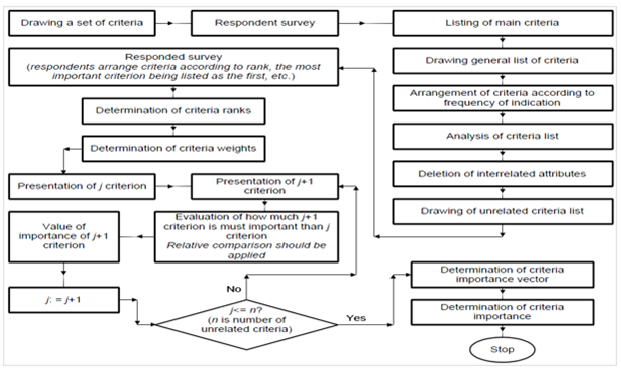
Step 1. The criteria are sorted in descending order based on their expected importance.
Step 2. Starting with the second criterion, the respondent expresses the relative importance of criterion j in relation to the previous criterion (j-1) for each specific criterion. This ratio is called the comparative importance of average value, sj.
Step 3. Determination of the coefficient kj as follows:

Step 4. Determination of the recalculated weight qj as follows:

Step 5. The relative weights of the evaluation criteria are determined as:

Wj indicates the relative weight of the j-th criterion, while n indicates the number of indicators.
The values of all quantitative indicators (X) are transformed to qualitative indicators (Xq) using the following relation:

Finally, the score of each building is calculated using the following equation

Results and Discussion
General overview
Table 6 shows the heat map of the evaluation by the 29 experts of the set of indicators established in the previous section. It shows that the majority of experts (around 66%) gave a high score (S=4) to a very high score (S = 5), while only 10% gave a very low (S=1) to low (S=2) scores to the set of indicators. Around 24% of the experts gave an intermediate score (S=3). However, the global score varies between 99 (use of the buildings for social activity) to 127 (thermal comfort), with a mean value of 113 and a standard deviation of 10.5.
Table 6: Heat-map results based on number of respondents to each category and indicator.

Rank and weight of sustainability categories
Table 7 shows the rank and weight of each category of indicators as calculated by the SWARA method and the scores in Table 6. The values of parameters sj, Kj, qj and Wj are determined by the equations Eq. 1 to Eq. 5 presented in section 3.1.
Table 7: Ranks and weights of the sustainability categories according to the experts’ opinion and the SWARA method.

According to the experts, it indicates that Energy efficiency and Indoor environment obtained the highest rank, which means that these categories are of the highest importance in public buildings’ sustainability. This result agrees with the importance of energy in the international sustainability certificates. It also highlights the importance of energy in Palestine because of the lack of resources. Experts also highlighted the importance of the indoor environment in public buildings for both the health and productivity of employees and users’ comfort. The social dimension obtained the lowest rank. In the Palestinian context, this dimension is not considered by experts as a significant issue.
Table 8 provides the weights of the sustainability categories in the Palestinian Green Building Guideline (PGBG). It shows that this guideline does not consider the social and economic categories. It agrees with the experts’ opinion concerning the importance of energy efficiency, but it provides for water a higher priority than that given by the experts. This difference could be related to the low consumption of water in public buildings. Nevertheless, both the PGBG and experts agree with the importance of the sustainability category associated with the indoor environment.
Table 8: The weight of sustainability categories in the Palestinian Green Building Guideline (PGBG).
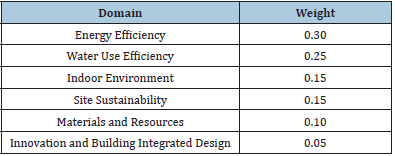
Importance of indicators in each category
This section analyzes the importance of indicators in each category according to the experts’ opinions. This analysis is based on the global score of each indicator. It also provides the weight of each indicator in its category as determined by the SWARA method. This weight could be used for the determination of the score of each category. The global score could then be determined according to the weights of categories provided in Table 7. Table 9 shows the rank and weight of the indicators of the category Energy Efficiency. It could be observed that the 4 indicators have close scores and consequently close weights. Therefore, experts consider that these indicators are of almost the same importance and should be considered in assessing the sustainability of public buildings.
Table 9: Rank and weight of indicators of the Energy efficiency category.

Table 10 summarizes the rank and weight of the indicators related to the Water efficiency category. It shows that the global water consumption obtains the highest weight, followed by the connection of buildings to the public sewage service. Rainwater harvesting also gets a high weight, which indicates the importance of this issue in Palestine because of water shorting. On the other hand, hot water and water consumption for irrigation obtained the lowest weights because of their low use in public buildings.
Table 10: Rank and weight of indicators of the water efficiency category.
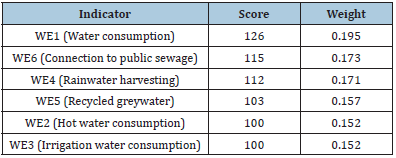
Table 11 provides the results related to the indicators Green City. The green space and Solid Waste production obtained high and close weights, while the greenhouse gas emission obtained a low weight. This result shows that greenhouse gas emission is not yet considered a major environmental issue by experts. Results concerning the indicators of the Indoor Environment are given in Table 12. Experts’ opinion shows that care should be paid in public buildings for thermal comfort, air quality, and safety, which obtained high and close scores. While humidity and acoustic comfort are considered of lower priority. Table 13 summarizes the results related to the indicators of the social category. Access to public transport service obtained the highest weight, while the other indicators obtained closed scores. Therefore, according to the experts’ opinion, public buildings should be accessible by public transport service. On the other hand, the occupation rate of public buildings and their use for social activity are considered of low importance.
Table 11: Rank and weight of indicators of the category Green city.

Table 12: Rank and weight of indicators of the indoor environment category.
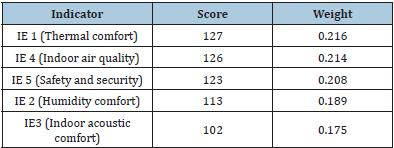
Table 13 summarizes the results related to the indicators of the social category. Access to public transport service obtained the highest weight, while the other indicators obtained closed scores. Therefore, according to the experts’ opinion, public buildings should be accessible by public transport service. On the other hand, the occupation rate of public buildings and their use for social activity are considered of low importance. Concerning the economic category, the expenses related to energy consumption are considered of high importance, while those related to water consumption are less important (Table 14). This result could be associated with the low water consumption in public buildings as compared to water consumption.
Table 13: Rank and weight of indicators of the social category.
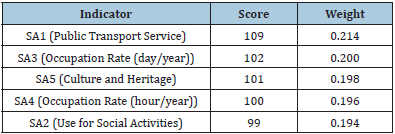
Table 14: Rank and weight of indicators of the economic category.

Conclusion
This paper presented a framework for the assessment of
existing public buildings in Palestine. It aims to assist the public
authority in establishing standards for sustainable buildings and
evaluating the sustainability of existing public buildings. The
framework is based on the review of international standards for
sustainable buildings, their adaptation to the Palestinian context,
and the opinion of a panel of experts.
The proposed framework includes 25 indicators covering
six categories of sustainability, namely energy efficiency, water
efficiency, green city, indoor environmental, social aspects, and
economic aspects. According to the experts’ opinion, Energy
efficiency and indoor environment are of the highest importance in
public buildings, while the social dimension is less important.
Both energy consumption and renewable energy production
are essential in the energy efficiency category, while water
consumption is considered very important in the water efficiency
category. Furthermore, experts highlighted the importance of the
ratio of green space and solid waste production in the category
of green city and that of thermal comfort, indoor air quality, and
safety in the indoor environment category. Finally, accessibility by
public transport and energy expenses were considered as the most
important in the economic and social categories, respectively. In
future work, this work will be pursued by enlarging the experts’
panel to civil society representatives and experts in the economic
and social sectors.
References
- Jensen PA, Maslesa E, Berg JB, Thuesen C (2018) 10 questions concerning sustainable building renovation. Building and Environment 143: 130-137.
- Suman N, Marinic M, Kuhta M (2020) A methodological framework for sustainable office building renovation using green building rating systems and cost-benefit analysis. Sustainability 12(15): 1-21.
- Balaras CA, Droutsa KG, Dascalaki EG, Kontoyiannidis S, Moro A, et al. (2019) Urban sustainability audits and ratings of the built environment. Energies 12(22).
- Akhanova G, Nadeem A, Kim JR, Azhar S (2019) A framework of building sustainability assessment system for the commercial buildings in Kazakhstan. Sustainability 11(17): 1-24.
- Sharma A, Saxena A, Sethi M, Shree V (2011) Life cycle assessment of buildings: A review. Renewable and Sustainable Energy Reviews 15(1): 871-875.
- Solino AS (2019) Sustainability of public services: Is outsourcing the answer? Sustainability 11(24).
- Gelderman CJ, Semeijn J, Vluggen R (2017) Development of sustainability in public sector procurement. Public Money and Management 37(6): 435-442.
- Pardo Bosch F, Aguado A, Pino M (2019) Holistic model to analyze and prioritize sustainable urban buildings for public services. Sustainable Cities and Society 44: 227-236.
- Li Q, Ruyin L, Hong C, Feiyu C, Jiaqi W (2019) Visualized analysis of global green buildings: Development, barriers and future directions. Journal of Cleaner Production 245: 118775.
- Mahmoud S, Zayed T, Fahmy M (2018) Development of Sustainability Assessment Tool for Existing Buildings. Sustainable Cities and Society 44: 99-119.
- Ali HH, Al Nsairat SF (2009) Developing a green building assessment tool for developing countries- case of Jordan. Building and Environment 44(5): 1053-1064.
- Vyas GS, Jha KN (2016) Civil engineering and environmental systems identification of green building attributes for the development of an assessment tool: A case study in India. Civil Engineering and Environmental Systems 33(4): 1–22.
- Banani R, Vahdati MM, Shahrestani M, Clements Croome D (2016) The development of building assessment criteria framework for sustainable non-residential buildings in Saudi Arabia. Sustainable Cities and Society 26: 289-305.
- Kersuliene V, Zavadskas EK, Turskis Z (2010) Selection of rational dispute resolution method by applying new stepwise weight assessment ratio analysis (SWARA). Journal of Business Economics and Management 11(2): 243-258.
- Ardda N, Mateus R, BL (2018) Methodology to identify and priorities the social aspects to be considered in the design of more sustainable residential buildings-Application to a developing country. Buildings 8(130).
- Road D (2017) Adapting sustainability in Palestine; barriers and motivators in the implementation of green architecture. 13th International Postgraduate Research Conference (IPGRC 2017), pp. 891-901.
- Shad R, Khorrami M, Ghaemi M (2017) Developing an Iranian green building assessment tool using decision-making methods and geographical information system: A case study in Mashhad city. Renewable and Sustainable Energy Reviews 67: 324-340.
- Mokhtarmanesh S, Ghomeishi M (2019) Participatory design for a sustainable environment: Integrating school design using students’ preferences. Sustainable Cities and Society 51: 101762.
- Tammy T, Atanda J, Baird G (2017) Development of a building performance assessment and design tool for residential buildings in Nigeria. Procedia Engineering 180: 221-230.
- Olawumi TO, Chan DWM (2018) Identifying and prioritizing the benefits of integrating BIM and sustainability practices in construction projects: A Delphi survey of international experts. Sustainable Cities and Society 40: 16-27.
- Zolfani SH, Chatterjee P (2019) Comparative evaluation of sustainable design based on step-wise weight assessment ratio analysis (SWARA) and Best Worst Method (BWM) Methods: A perspective on household furnishing materials. Symmetry 11(1): 1-31.
- Zolfani SH, Saparauskas J (2013) New application of SWARA method in prioritizing sustainability assessment indicators of energy system. Inzinerine Ekonomika-Engineering Economics 24(5): 408-414.
© 2021 Aya Baba. This is an open access article distributed under the terms of the Creative Commons Attribution License , which permits unrestricted use, distribution, and build upon your work non-commercially.
 a Creative Commons Attribution 4.0 International License. Based on a work at www.crimsonpublishers.com.
Best viewed in
a Creative Commons Attribution 4.0 International License. Based on a work at www.crimsonpublishers.com.
Best viewed in 







.jpg)






























 Editorial Board Registrations
Editorial Board Registrations Submit your Article
Submit your Article Refer a Friend
Refer a Friend Advertise With Us
Advertise With Us
.jpg)






.jpg)














.bmp)
.jpg)
.png)
.jpg)










.jpg)






.png)

.png)



.png)






